Orange Birch Bolete and Brown Birch Bolete – Identification, Edibility, Distribution
Leccinum versipelle (OBB), Leccinum scabrum (BBB)
(also very similar: orange oak bolete (Leccinum aurantiacum) and orange aspen bolete (leccinum insigne) – distinguished by habitat.
- Edibility – 4/5 – OBB – Young firm specimens great in any mushroom dish, large, spongier specimens best dried. Stems can become tough and hard to digest, especially in older specimens – in which case add to the stock pot fresh, or dry and powder to use in stock mixes. BBB- 2/5 (or 3/5 if really young and firm) – usually best dried and mixed with other dried fungi and used as thickener/umami in stock pots. As with OBB, stops can be tough and hard to digest.
- Identification – 4/5 – OBB – Its hard to mistake these impressive fungi, with their orange caps, pale stems with dark scales (squamules) , grey pores and tendency to turn blue around the stem base when cut or handled. Don’t be alarmed by this – treat it as a welcome aid to identification rather than something scary (see picture at bottom of page). BBB is more or less identical, only with drab brown caps of various hues depending on how young/wet it is, and an inclination to bruise grey rather than blue. There are a number of similar leccinum (scaber stalk) species, all of which share the more or less squamulous stipe. Identification to species is based on habitat (i.e. tree type they are found under), cap colour and colour changes (blue, red, dark bruising) on cut stems. None are known to be toxic or inedible, but some are harder do digest than others. See notes on a couple more below, and consult a field guide for the full range.
- Distribution – OBB – 3/5 – Not uncommon in their habitat, though far less common than BBB (5/5), which are often hyper abundant under birch.
- Habitat – Under birch trees and no other, August – November. If you find an orange capped mushroom that looks very similar growing under oak or aspen, you probably have an orange oak bolete (Leccinum aurantiacum – edible and excellent) or orange aspen bolete (leccinum insigne – edible but with some reports of adverse reactions).
While not quite in the same class as ceps, orange birch boletes far exceed their more common brethren, the brown birch bolete (leccinum scabrum), in texture and flavour. Look for somewhat phallic younger specimens only under birch trees (especially scrub birch and birch wood edges), particularly on acidic, scrubby/heathery ground. They can grow to substantial sizes, but once they start to feel spongy its best to dry them for future use. Drying results in an improved flavour on reconstitution.
If you come across an OBB (to its friends) that isn’t growing beneath birch, but under oak trees, you may well have an OOB – orange oak bolete. Word is, these are even tastier, but never having found one, I can’t comment. They seem to be more common in the South of England. We don’t get many aspens in Scotland, but on a trip to NW Canada I encountered a lot and found lots of orange aspen boletes below them. Orange aspen boletes have been reported to cause adverse reactions in a few people – my advice would be to eat only the young caps, well cooked. I really enjoyed them.
None of the scaber-stalk (leccinum) sub-family of boletes (pored mushrooms) will do you much harm, though many aren’t particularly rewarding eating. I get countless pictures of BBB’s sent to me by people thinking they have found ceps. They are nowhere near as good, though young, firm specimens are well worth picking, and often reward a forage in huge numbers when not much else is about.
I’m told that in some areas of Eastern Europe the OBB is esteemed above the cep. This is hard to justify purely on taste grounds, but they are certainly more rewarding picking, being much more resistant to maggots.
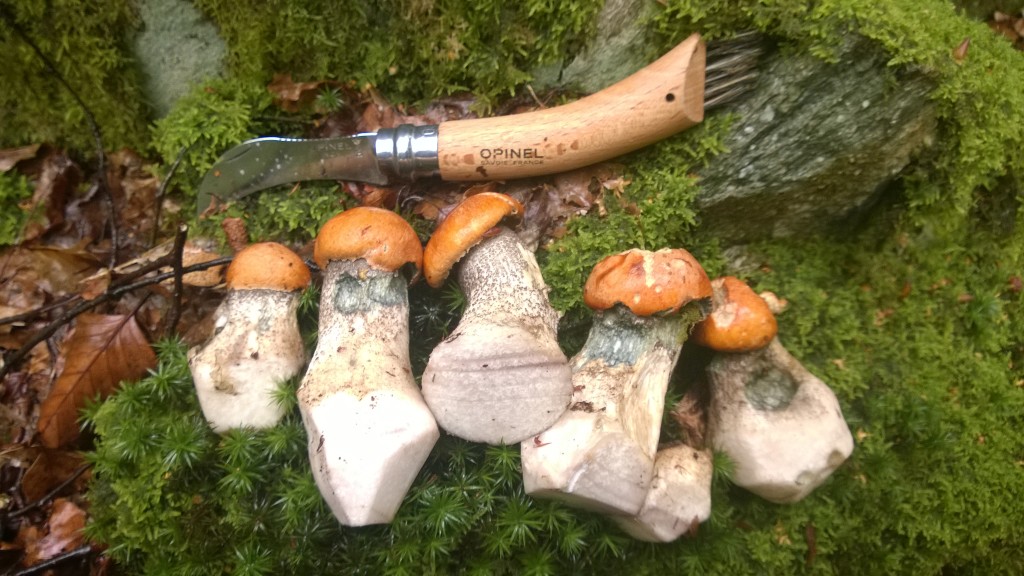
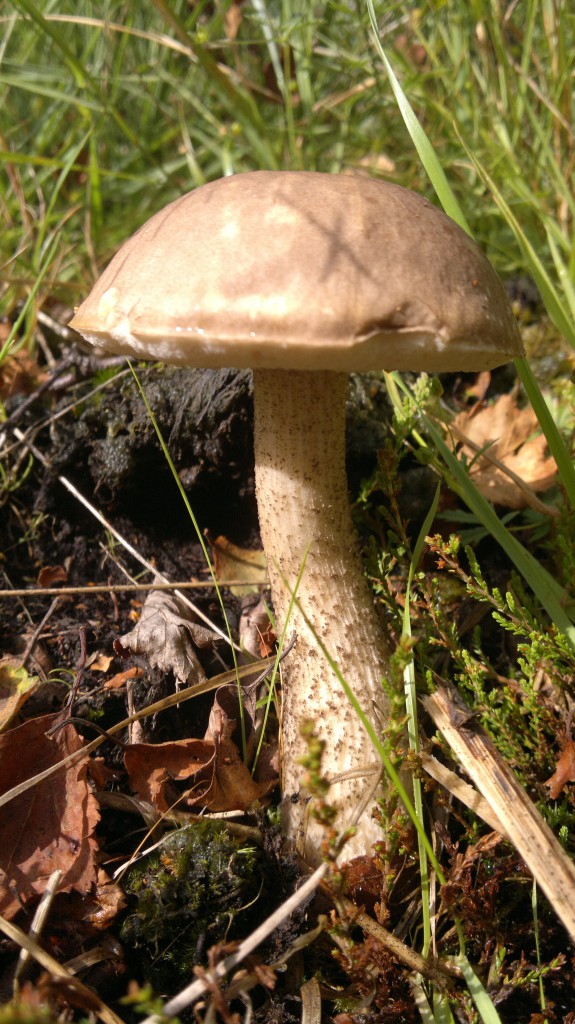
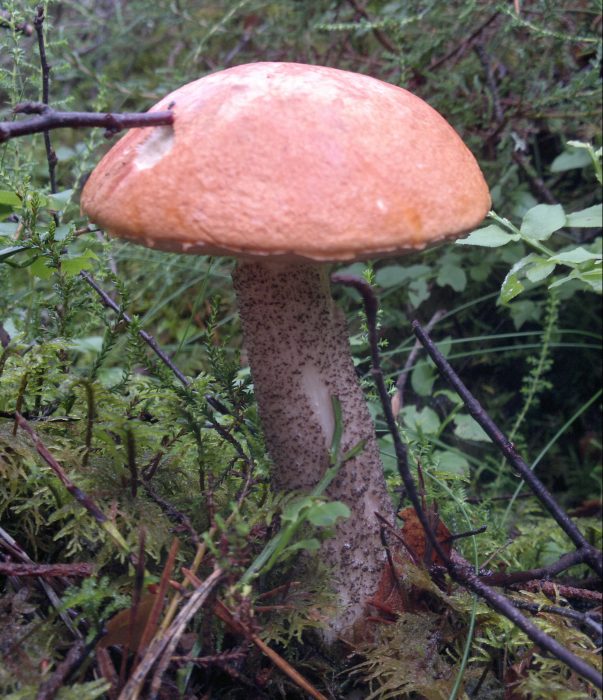

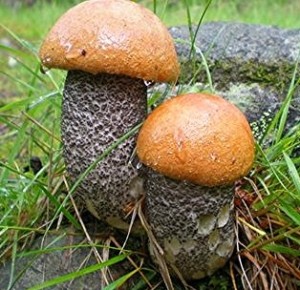
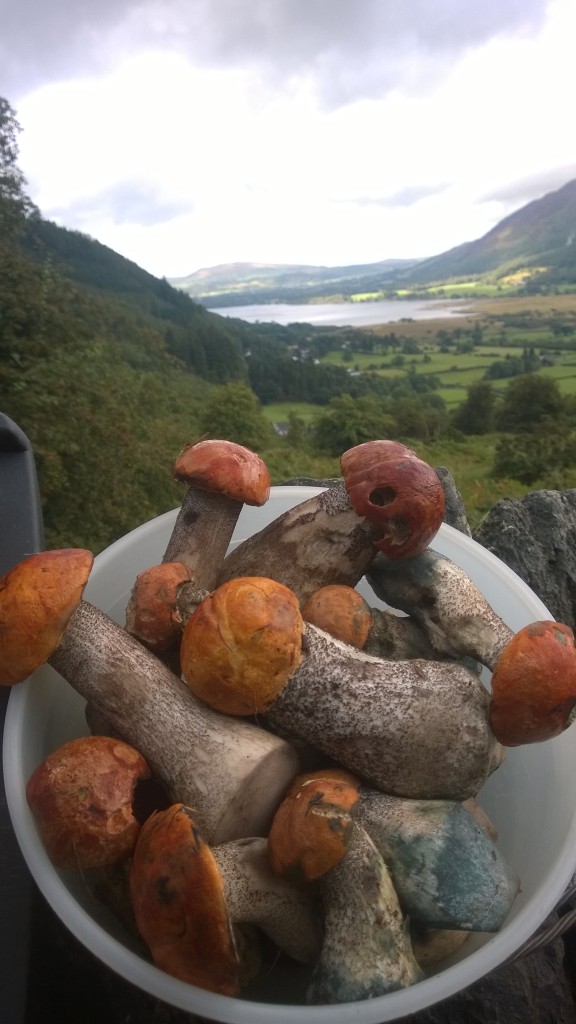
20 Comments
Hi I picked some brown birch boletes and have had a go at drying them in the oven at 100°c turning them every 10 mins interestingly the older larger specimens which I had less hope for kept their colour much better after drying although they were much harder to put through the mandolin..the younger ones have all gone really grey where the white once was it this acceptable?can send photos if you like…a response would be most welcome!
Hi Josh, Discolouration while drying is normal with these species. The stipes of older specimens can get quite tough and harder to digest – drying and powdering is the way to go.
Mark
Found some beautiful orange birch bols in Perthshire this week – dont normally see the orange ones in good condition – cooked the stems only as caps quite softish; however had very bad diahorea 12 hours later , which I am putting down to the mushrooms. Luckily didnt give to my elderly parents with the tea.
Just a cautionary note – I am well experienced in mushrooms otherwise – maybe best to go gently with these ones to see if agree with oneself, before going in head first. David, West Lothian.
Hi David,
Sorry to hear you didn’t get on.
Good advice: Eating anything for the first time, but especially fungi, is a step into the unknown. Eating a small amount, well cooked, is always the way to go initially. Personally I remove the tough stipes of older specimens as they just look tough to digest. Drying is the best way to go with soft caps. There are a range of orange leccinum, mostly distinguished by habitat. Some are more easy to digest than others.
Cheers,
Mark
Hello Mark 🙂
Just want to say thank you for all of the interesting information and pictures.
P.S. A little off top; I do wish I had someone (near me) so I can be somewhat assured about the mushrooms I see that may be potentially edible 🙂
I am confused about Boletes. I saw few beautiful specimens with nice reddish-orange caps and “scaly trunks”. I cut gently one off and it bruised right away at the cut.
I don’t expect an answer from you. LOL
I just have a hard time distinguishing pictures from real looking mushrooms.
I am taking your advice: If not sure, leave it alone 🙂
Thanks again.
Hi Mark. This is my first comment on this site after lurking for a while, and it’s in favour of an apparently mediocre mushroom.
I recently found a brown birch bolete, a firm and young but well developed specimen. I wasn’t sure of its identity as the cap was slightly on the grey side but I am positive it couldn’t have been anything else. At any rate I confirmed it thanks to your site, however I was disappointed to then see it had been given a middling rating. I thought “well, the worst that’s going to happen is I find it boring.”
At any rate, I sliced it and fried it in a little olive oil in the bottom of a small saucepan until the slices went crispy and I’ve got to say I was pleasantly surprised! It was very savoury and more-ish. I was going to wait until my mum came back to the kitchen after taking my dad a cup of tea but, alas, my resolve was lacking. I scoffed the rest. Now, this may be down to individual tastes, my luck with an individual specimen or my palette of low expectations. Either way, this mushroom definitely has the potential to serve a forager well and I look forward to finding more.
At any rate, I love the site. I live in the south/south west of England and have for a couple years been hankering to do pretty much exactly what you have done on this website. Explore all the wild plants and fungi of Britain and find unexpectedly exotic, unique or otherwise notable flavours and spices hidden in our fields, woodlands and hedgerows, which started when I first nibbled the lemony bite of wood sorrel and was determined to prove that for many exotic spices we import, there is a plant or fungi which provides an equivalent, or even something fairly unique such as in the form of Angelica, with its aromatic sweetness reminiscent of Victorian-styled medicinal sweets. It’s my aim to help raise Britain’s awareness of its native, wild spice rack and vegetable allotment and growing them with the admiration and respect one gives Mediterranean squashes and exotic chilis.
I’m glad you enjoyed your BBB Jeremy. Young firm ones can be pretty good, especially crisped a little. Pleased to hear you are exploring our native spice rack. I guess you have listened to the Radio 4 programme we made and read my blog on it..?
Hi I found some brown Birch Boletes they looked wonderful i was over the moon so I left them out to dry naturaly,?” days later found them going a bit spongy and soft a bit mushy, broke one up riddled with maggots,??? This really put me on a downer!, how can this be avoided in the future,? Is there any preparation to preserve these and to get rid of maggots,??
Many thanks
Quick dehydration, ideally with a proper dehydrator is the way. Beasties fall out and you are left with excellent dried mushroom.
I live now in Canada, but experience with mushrooms comes from Europe, Poland’s Tatra Mountains. Boletus Red or Brown are called “KOZAK”. Big thing about eating them, as I noticed, is the preparation. I clean, scrape the bottom, and rinse the rest, cut the mushroom up into 1/4 inch thick pieces, more or less, to the frying pan with a 1/4lb of butter (to a full pan with hip), cover up the pan tight, and let the heat do the work, slowly bring it to boil. Do not uncover pan till the mushrooms are soft. When the mushrooms give the juice, mixed with butter, and are soft, uncover the pan, and let the moisture boil off. I do not add more salt to it, when I use the salted butter. They are delicious, and easy absorbed by the stomach, when done like that, not to mention they are so tasty. Some days I add to them Buttercup that are yellow to brown in color, and do not go dark after cut. Both can also be made in preserve with vinegar, onions, all spice, and bay leaves with a bit of salt and sugar. They taste really good in winter, before main dish.
I have a pic of what I think is an OBB I would like to send a picture. Very new at this. But excited to learn.
I’m happy to try to help with fungi ID, but there are some rules: http://www.gallowaywildfoods.com/help-identifying-wildfood/
So excited! Went into our woodland today (naturally regenerating celtic rainforest) and was almost instantly able to recognise BBB. I’m so grateful for all the info you share and do hope to get on one of you foraging walks in the not too distant future. There is so much life in the woods; it is a joy to know the names of some of the species that share it with me
I think I may have found two white vespelles (i.e. white ‘orange’ birch boletae) near Kinlochewe, NW Scotland. Seems like you operate in a similar habitat, so I was wondering if you’d ever found one or might be able to confirm the ID.
Colours were in constant flux – pale apricot cap that bruised brick red (bit like a blusher), highly concave on young specimin, flattening with age, no veil. Off-white olivaceous tubes that stained brown to black when damaged. Pure white stipe with squamules that later turned brown-black at the tips after being touched; straight, tapering to apex. The base of the stipes turned rosy at first, when I cut them from the ground, but had gone deep blue by the time I got home and black by evening. When I sliced the shroom I saw the blackened base of the stipe was was still brilliant aquamarine a couple of millimeters in. The younger specimin’s flesh went from white to rosy after being cut, then mauve, then sky blue with a white sheen which made it look irridescent, at which point it went in the pan and num num num num num…
The older specimin produced an ochre/rosy spore print, but colours on slicing have been less spectacular than the little guy’s.
However, it’s the first I’ve ever found after many years foraging up here, so I’m a little concerned it might have been rather rare and should have been left in the ground. If you have a view on that, I’d be glad to hear it.
duh – I meant convex not concave…
There are quite a number of leccinum species that don’t make it into regular guide books (or my guide here), including the ghost bolete, l.holopus, which may fit your description. It is edible. Orange, and especially brown BBs can be quite variable within species, and have plenty of close lookalikes that are mostly distinguished by habitat and mycoscropy. Ghost boletes aren’t super common, but neither are they especially rare, and I suspect the fungus, if it could, might thank you for moving its spore-bearing structure to new potential habitats… 🙂
Hello I went with my husband mushroom picking as he has done it since he was able to walk basically and we found many of these but when I tried to dry them at 65 in oven all the porcini, ceps, dried perfect but the orange ones dried jet black.. I was worried because I also made a soup and a pasta dish with them. Husband was fine but he has a resilient stomach.. any reason they would turn so black? Thanks!
The blackening (especially of the stems) on drying is quite normal. An oxidation reaction I think – a bit like apples going brown. Doesn’t affect edibility.
Mark.
Is there any evidence for BBB’s being medicinally worthwhile?
Not that I am aware of.